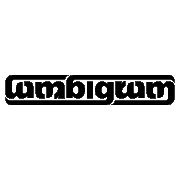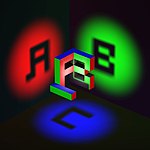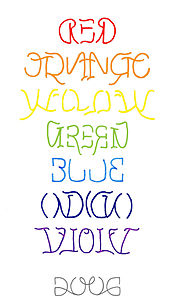Ambigram
From Wikipedia, the free encyclopedia
An ambigram, also sometimes known as an inversion, is a typographical design that spells out one or more words not only in its form as presented, but also from another view point, direction or orientation. The words spelled out in the other view point, direction or orientation may be the same or different from the original words. Douglas R. Hofstadter describes an ambigram as a "calligraphic design that manages to squeeze two different readings into the selfsame set of curves."
The National Puzzlers' League uses the word "ambigram" to mean an ambiguous anagram.[1]
Contents |
[edit] Invention and popularity
Ambigrams have been independently invented by a number of artists. According to John Langdon, ambigrams were independently invented by himself and by Scott Kim in the 1970s.[2] Langdon and Kim are probably the two artists who have been most responsible for their popularization, but other artists, notably Robert Petrick, who designed the Angel logo, claim to be independent inventors. Some earlier ambigrams are known, but each of the artists created those ambigrams created only one or a few.
The earliest known non-natural ambigram dates to 1893 by artist Peter Newell. Although more well known for his children's books and illustrations for Mark Twain and Lewis Carroll, he published two books of invertible illustrations, in which the picture turns into a different image entirely when turned upside down. The last page in his book, Topsys & Turvys contains the phrase THE END, which, when inverted, reads PUZZLE. In Topsys & Turvys Number 2 (1902), Newell ended with a variation on the ambigram in which THE END changes into PUZZLE 2.
From June to September, 1908, the British monthly The Strand published a series of ambigrams by different people in its "Curiosities" column.[3][4][5] Of particular interest is the fact that all four of the people submitting ambigrams believed them to be a rare property of particular words. Mitchell T. Lavin, whose "chump" was published in June wrote "I think it is in the only word in the English language which has this peculiarity," while Clarence Williams wrote, about his "Bet" ambigram, "Possibly B is the only letter of the alphabet that will produce such an interesting anomaly."
In 1969, Raymond Loewy designed the NEW MAN logo, which is still in use today.[6] The DeLorean Motor Company logo was first used in 1975.[citation needed]
Kim used the name Inversions as the title of his first collection in 1981. The first published reference to the term "ambigram" was by Hofstadter, who attributed the origin of the word to conversations among a small group of friends during 1983–1984. The original 1979 edition of Hofstadter's Gödel, Escher, Bach featured two 3-D ambigrams on the cover.
Ambigrams became much more popular as a result of Dan Brown incorporating them into the plot of his bestseller, Angels & Demons; Langdon produced ambigrams that were used for the book cover, and a link to his website from Brown's meant he was "suddenly inundated" with commissions.[2] Brown used the name Robert Langdon for the hero in his novels as an homage to John Langdon.[7]
Today, ambigrams are available on a variety of products and have become popular for tattoos.
[edit] Milestones in the history of ambigrams
| 1893 | First known ambigram published by Peter Newell (THE END / PUZZLE) |
| 1902 | Second known ambigram published by Peter Newell (THE END / PUZZLE2) |
| 1908 | The Strand publishes 10 ambigrams by four different artists |
| c1964 | Peter Jones and Douglas Hofstadter start creating ambigrams |
| 1965 | Dmitri Borgmann reprints ambigrams from The Strand, calling them "vertical palindromes" |
| 1969 | Raymond Loewy creates NEW MAN logo |
| 1972 | Tom Carnase creates 72 |
| 1974 | John Langdon creates STARSHIP ambigram logo |
| 1974 | Robert Petrick creates Canned Heat and Non Sense logos (they receive a Philadelphia Art Directors' award in 1975) |
| 1975-1976 | U&lc magazine publishes ambigrams by Petrick and Langdon, starting with SANTA/ELVES by Petrick in June, 1975 issue[8][9][10] |
| 1975 | DMC, the logo for the De Lorean Motor Company, first used |
| 1975 | Robert Petrick creates ANGEL ambigram logo |
| 1976 | Angel band starts using Angel ambigram (through 1992) |
| 1976 | Jefferson Starship uses Starship ambigram |
| 1979 | OMNI publishes ambigrams by Kim in Scot Morris's "Games" column |
| 1979 | Gödel, Escher, Bach by Douglas Hofstadter, published, with 3-D ambigrams on the cover |
| 1980 | OMNI publishes ambigrams by Langdon and Petrick |
| 1981 | Scientific American publishes ambigrams by Scott Kim in Martin Gardner's Mathematical Games column |
| 1981 | Inversions: A Catalog of Calligraphic Cartwheels by Kim is published |
| 1983-1984 | The word "ambigram" is coined |
| 1992 | Wordplay: Ambigrams and Reflections on the Art of Ambigrams by Langdon is published |
| 2000 | Angels & Demons by Dan Brown is published |
[edit] Ambigram types
Ambigrams are exercises in graphic design that play with optical illusions, symmetry and visual perception. Some ambigrams feature a relationship between their form and their content. Ambigrams usually fall into one of several categories:
- Rotational
- A design that presents several instances of words when rotated through a fixed angle. This is usually 180 degrees, but rotational ambigrams of other angles exist, for example 90 or 45 degrees. The word spelled out from the alternative direction(s) is often the same, but may be a different word to the initially presented form. A simple example is the lower-case abbreviation for "Down", dn, which looks like the lower-case word up when rotated 180 degrees.
- Mirror-image
- A design that can be read when reflected in a mirror, usually as the same word or phrase both ways. Ambigrams that form different words when viewed in the mirror are also known as glass door ambigrams, because they can be printed on a glass door to be read differently when entering or exiting.
- Figure-ground
- A design in which the spaces between the letters of one word form another word.
- Chain
- A design where a word (or sometimes words) are interlinked, forming a repeating chain. Letters are usually overlapped meaning that a word will start partway through another word. Sometimes chain ambigrams are presented in the form of a circle.
- Space-filling
- Similar to chain ambigrams, but tile to fill the 2-dimensional plane.
- Spinonym
- An ambigram in which all the letters are made of the same glyph, possibly rotated and/or inverted. WEB is an example of a word that can easily be made into a spinonym.
- Fractal
- A version of space-filling ambigrams where the tiled word branches from itself and then shrinks in a self-similar manner, forming a fractal. See Scott Kim's fractal of the word TREE for an animated example.
- 3-dimensional
- A design where an object is presented that will appear to read several letters or words when viewed from different angles. Such designs can be generated using constructive solid geometry.
- Perceptual shift (also called an oscillation)
- A design with no symmetry but can be read as two different words depending on how the curves of the letters are interpreted.
- Natural
- A natural ambigram is a word that possesses one or more of the above symmetries when written in its natural state, requiring no typographic styling. For example, the words "dollop", "suns" and "pod" form natural rotational ambigrams. In some fonts, the word "swims" forms a natural rotational ambigram. The word "bud" forms a natural mirror ambigram when reflected over a vertical axis. The words "CHOICE" and "OXIDE", in all capitals, form natural mirror ambigrams when reflected over a horizontal axis. The word "TOOTH", in all capitals, forms a natural mirror ambigram when its letters are stacked vertically and reflected over a vertical axis.
- Symbiotogram
- An ambigram that, when rotated 180 degrees, can be read as a different word to the original.[citation needed]
- Multi-lingual
- An ambigram that can be read one way in one language and another way in a different language. Multi-lingual ambigrams can exist in all of the various styles of ambigrams, with multi-lingual perceptual shift ambigrams being particularly striking.
- Ambigraf
- A style of ambigrams which abide by the conventions of ambigrams but are designed in the graffiti style in terms of line and shape- and context- written on walls as stencils. It is an artform developed by artist SlantOne.[citation needed]
[edit] Creating ambigrams
There are no universal guidelines for creating ambigrams. Ambigrammists have different ways of approaching problems. A number of ambigrammists have published information on the methods they use. Langdon's WordPlay and Burkhard Polster's Eye Twisters, in particular, contain information useful to new ambigrammists.
There have been a few attempts at automated creation of ambigrams, two of which have been available on the Internet. The first, the letter-based ambigram generator Ambigram.matic[11], was created in 1996 by David Holst, using a database of 351 letter glyphs, in which each letter mapped to another letter. The generator could only map a word to itself or to another word that was the same length. Because of this, most of the generated ambigrams were of poor quality.[12]
The second generator, the Glyphusion generator (created by ambigram artist Mark Palmer and programmer Mark Hunter), is used by FlipScript (a web retailer of personalized ambigram products), WowTattoos (a web retailer of Palmer's ambigram tattoo designs) and other companies, and was created in 2007. According to the company, the Glyphusion generator uses a database of more than 200,000 parts of letters[13]. Because the generator uses parts of letters, its results are significantly better than the earlier letter-based generator, but is still limited when compared with a human artist. It currently (2009) generates ambigrams in two lettering styles (blackletter and a cursive-esque script) and it cannot produce ambigrams in some cases.
[edit] Other names
Ambigrams have been referred to by other terms, both before the term was coined and afterwards. In his 1965 book, Language on Vacation: An Olio of Orthographical Oddities, Dmitri Borgmann reprinted some of the ambigrams from The Strand (without attribution) and named them "vertical palindromes" (page 27).
When OMNI magazine published ambigrams by Scott Kim in September 1979, they were dubbed "designatures."
Many people were introduced to ambigrams through the work of Scott Kim, who called them inversions, most notably in his 1981 book.
[edit] Examples
Graphic artists use ambigrams because of their unique symmetry. Ambigrams thus appear in commercial logos, covers of books and music albums, and tattoo designs.
Ambigrams feature prominently in Dan Brown's novel, Angels and Demons, of which the first UK release featured an ambigram of the title on the cover. The ambigrams in the novel were designed by graphic artist John Langdon. Since the release of the bestseller sequel The Da Vinci Code, there has been a marked increase in the popularity and awareness of ambigrams, leading to a reprint of John Langdon's book on ambigrams titled Wordplay.
The book, "Body Type" by Ina Saltz features several examples of ambigrams in tattoo form, including several John Langdon designs.
Another example appears in the short story Emma Zunz by Jorge Luis Borges. In this case, the surname of the eponymous main character can be read the same way right side up and upside down.
The following ambigram examples all have rotational symmetry, unless otherwise noted.
[edit] Books
- "Abarat," on the cover of the book by Clive Barker. (See on the book page)
- "Angels and Demons," on the cover of the first edition of Angels and Demons by Dan Brown, as well as the Illuminati brands in the text. (see on the book page)
- GEB (3-dimensional ambigram), on the cover of Gödel, Escher, Bach by Douglas Hofstadter. (see on Gödel, Escher, Bach page)
- "Justin Thyme," on the cover of Justin Thyme by Panama Oxridge.
- "Wordplay," on the cover of John Langdon's book on ambigrams. The author's name also appears on the cover as an ambigram. (See on John Langdon page)
[edit] Music
- "ANGEL" logo[3], on the cover of a 1977 recording from Casablanca Records, designed by Robert Petrick. (See on Robert Petrick page)
- "CiRCADiAN", the logo and album cover of 5th PROJEKT's CiRCADiAN. (see here)
- The Grateful Dead, on their 1970 album American Beauty use an ambigram on the album's artwork. The title can be read as "American Reality" as well as "American Beauty"
- "Paul McCartney", on an alternate cover for his album Chaos and Creation in the Backyard. (See on album page)
[edit] Other logos
- "Saint/Sinner," the logo for Australian Gold's new bottle of indoor tanning lotion, designed by Mark Palmer
- "DMC," the logo for the De Lorean Motor Company.
- "NEWMAN," the logo for the French clothes manufacturer[14], designed in 1969 by Raymond Loewy.
- "BLACKSMITH," the logo of Warner Music Group's sub label Blacksmith Records[15]. (See on web site)
- "EIB", a logo used for "Excellence in Broadcasting" on the The Rush Limbaugh Show.
- "GOES," the logo for NASA's Geostationary Operational Environmental Satellite satellite, designed by Scott Kim. (See on Scott Kim page)
- "New X-Men", the logo for the comic book series
- The title on the cover of the 20th Anniversary DVD release of The Princess Bride. (See here)
- The "4S" SUN logo (rotationally symmetric chain ambigram), the logo for Sun Microsystems, designed by Vaughan Pratt. (See on the Sun Microsystems page)
- The "Tyrian" game logo. (See on the game page)
[edit] Ambigram-like logos
The following well-known logos are not ambigrams, but they have ambigrammatic properties
 , the logo for the band ABBA.
, the logo for the band ABBA. , the logo for the band Nine Inch Nails.
, the logo for the band Nine Inch Nails. , the logo for the U.S. Civil Defense, no longer in use as of 2006.
, the logo for the U.S. Civil Defense, no longer in use as of 2006.
[edit] In popular culture
Ambigrams have featured prominently in books and movies. A number of ambigrams by John Langdon are key to Angels & Demons by Dan Brown and also appear in the subsequent movie. The movie Monkeyshine by Cupsogue Pictures features an ambigram by Langdon as an essential plot element. The ambigram reads "Monkeyshine" one way and "Nightingale" when rotated 180 degrees.[citation needed]
Ambigrams have also been used by rock bands, including Angel and Jefferson Starship.[citation needed]
[edit] Practical uses of ambigrams
Sometimes, ambigrams can be used in practical ways, to allow something to be read from more than one direction. Some practical uses of ambigrams include:
- The "up"/"dn" arrow ambigram seen on some packing boxes.
- A doormat that reads "Come in" in one orientation and "Go away" in the other.
- AmbiScript[16] is an ambigrammatic font designed specifically for representing DNA sequences.
- The "Trick/Treat" cards used in Derren Brown's "Trick or Treat" TV series.
[edit] Other meanings
In the National Puzzlers' League, the word "ambigram" was coined by Judith E. Bagai to mean an ambiguous anagram. In League terminology, an anagram is a transposal (rearrangement) of letters which is an appropriate comment or description of an original word or phrase, while an antigram is an inappropriate comment or description. An ambigram is such a transposal in which the appropriateness is in the eye of the reader.[1]
[edit] See also
| Look up ambigram in Wiktionary, the free dictionary. |
| Wikimedia Commons has media related to: Ambigrams |
[edit] Notes
- ^ a b National Puzzlers' League, The, Guide to the Enigma, Second Edition, Foreworks Publications (2004)
- ^ a b "The doodle bug". The Telegraph. April 11, 2005.
- ^ "chump" ambigram in The Strand, June 1908
- ^ "honey" ambigram in The Strand, August 1908
- ^ Several ambigrams in The Strand, September 1908
- ^ http://raymond-loewy.un-jour.org/biographie_raymond_loewy.html, accessed March 3, 2009
- ^ "As a tribute to John Langdon, I named the protagonist Robert Langdon."
- ^ Petrick, Robert (June 1975). "SANTA/ELVES ambigram (reprint of Petrick's Christmas card from 1974)". U&lc 2 (2): 15.
- ^ Langdon, John (September 1975). "ANTOINE ambigram". U&lc 2 (3): 25.
- ^ Petrick, Robert (September 1976). "HERB ambigram (an homage to Herb Lubalin)". U&lc 3 (3): 31.
- ^ http://www.ambigram.com/matic/
- ^ See Polster, pp. 174-176
- ^ About FlipScript
- ^ [1]
- ^ [2]
- ^ http://www.peerascent.com/ambiscript/
[edit] References
- Borgmann, Dmitri A., Language on Vacation: An Olio of Orthographical Oddities, Charles Scribner's Sons (1965)
- Kim, Scott, Inversions: A Catalog of Calligraphic Cartwheels, Byte Books (1981, republished 1996)
- Hofstadter, Douglas R., "Metafont, Metamathematics, and Metaphysics: Comments on Donald Knuth's Article 'The Concept of a Meta-Font'" Scientific American (August 1982) (republished, with a postscript, as chapter 13 in the book Metamagical Themas)
- Langdon, John, Wordplay: Ambigrams and Reflections on the Art of Ambigrams, Harcourt Brace (1992, republished 2005)
- Hofstadter, Douglas R., Ambigrammi: Un microcosmo ideale per lo studio della creativita (Ambigrams: An Ideal Microworld for the Study of Creativity), Hopefulmonster Editore Firenze (1987) (in Italian)
- Polster, Burkard, Les Ambigrammes l'art de symétriser les mots, Editions Ecritextes (2003) (in French)
- Polster, Burkard, Eye Twisters: Ambigrams, Escher, and Illusions (date unknown)
- Polster, Burkard, Eye Twisters: Ambigrams & Other Visual Puzzles to Amaze and Entertain, Constable (2007)
[edit] External links
- Ambigrams, Logos, Word Art by graphic artist John Langdon
- Advice on Ambigrams, John Langdon's tutorial for beginning ambigrammists
- Inversions by Scott Kim
- The story of the invertible symmetrical "Angel" logo and beyond by Robert Petrick
- Ambigrams and wordplay by Punya Mishra
- Ambigrams at the Open Directory Project
- Ambigramania online community for Ambigram enthusiasts
- Flickr Ambigram Pool









